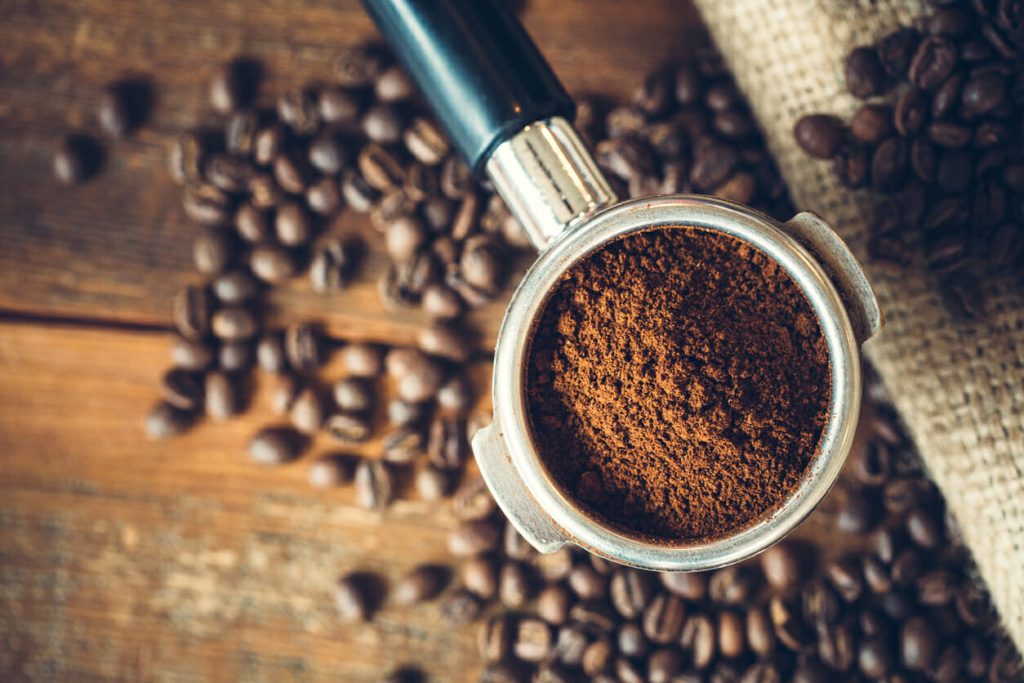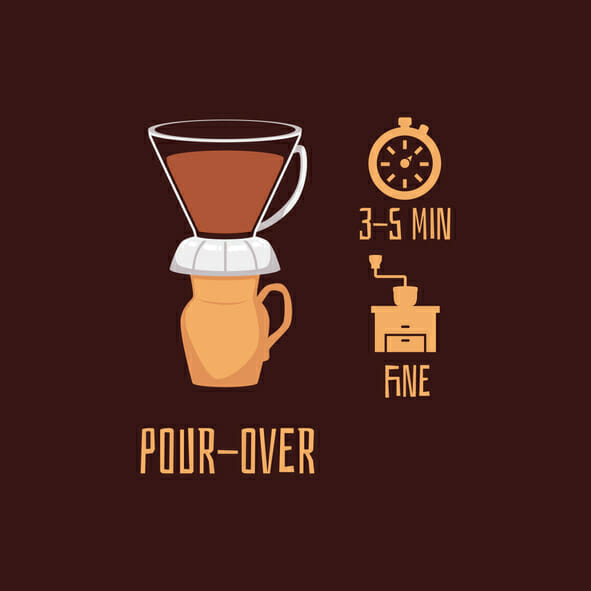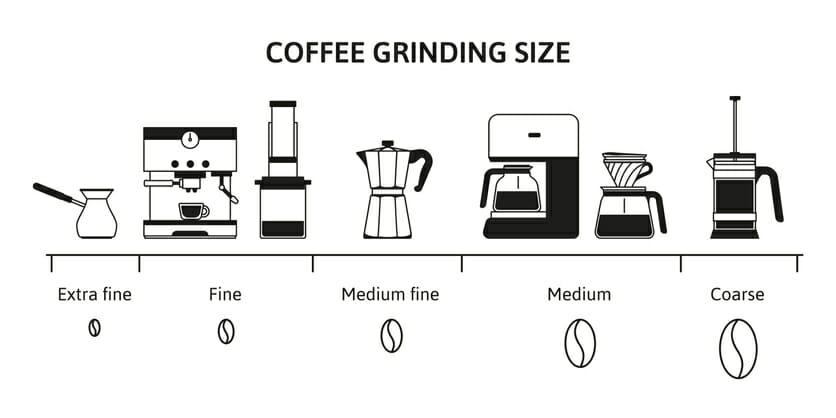If you’re tired of buying the same old package of stale, pre-ground coffee and have always wanted to try making coffee from whole beans, this guide is for you. We’re here to tell you that making your own excellent cup of coffee at home is a game changer, and it’s totally doable! When you begin making coffee, you’ll be able to make it exactly how you’d like, and you can even experiment with different methods to find your favorite. Let’s talk about how to get the best grind for your brew and explore some tips on making the best cup of joe at home.
Cupla’s Guide to the Perfect Coffee Bean Grind
Why grind your own beans?
It’s no secret that grinding fresh beans makes for a better cup of coffee, but do you know why? Coffee beans are a food product that is affected by outside factors. Unlike something synthetically produced, it can’t sustain a consistent flavor for an extended period of time. The outer shell of the bean protects the integrity of the flavor, guaranteeing a fresh taste once its ground. That’s why the answer to having an excellent cup is grinding your own beans at home.
The roasting and grinding process
When coffee is made, the beans are roasted to release their oils and help create the characteristic aroma for which coffee is known. The bean’s flavor is enhanced, bringing out any fruity and floral notes. While making coffee from whole beans is best, it does introduce the extra process of grinding your own beans. Though it may take a few additional minutes, we highly suggest grinding beans because it makes a big difference! And with our handy guide, you’ll be an expert in no time.
Once you’ve decided to start grinding your beans, the fun part begins – perfecting your grind. Keep in mind that the second coffee beans are ground, the essential oils start evaporating, and the coffee begins to lose freshness and flavor. And because the coffee flavor is mostly contained in the oil that coats the bean, it’s much better to grind coffee right before it is brewed. In short, it ensures maximum freshness and flavor, and you’ll be well on your way to having a superb cup of joe.
How to Achieve the Perfect Grind

While grinding your coffee isn’t difficult by any means, there are a few things to know before you start. During the process of brewing, the subtle flavors from the coffee bean are extracted using hot water. It’s a simple process, but you’ll want to get the steps right to ensure the best cup.
Invest in a Good Grinder
Investing in a good grinder is the first step to grinding your own beans. But with all the available options, finding the best machine for you and your needs might be difficult. In your search for coffee grinders, you’ll find two main types:
Blade Grinders
Blade grinders work by chopping up the coffee beans into tiny particles instead of just grinding them. The grinding is accomplished with the help of two blades that revolve at a very high speed, around 20,000-30,000 rotations per minute. With this type of coffee grinder, you can control the coarseness of the grind by how long you let the grinder chop up the beans. With the grinder, you have the ability to create coarsely-ground coffee beans or finely-ground coffee beans. In theory, the longer you run the grinder, the finer the grind.
While blade grinders may be easy to operate, they do have several drawbacks. First, they require an attentive eye and familiarity with grinding. Because many blade grinders do not have settings, you’ll need to recognize the different grind sizes and how to achieve the correct size for your brew. They are also prone to producing grinds of inconsistent sizes, which can result in inconsistent brew quality. On the other hand, they tend to be cheaper than other types of grinders, so that is a bonus for many people.
Burr Grinders
If you’re looking for a grinder to let you get the most flavor out of your grounds, you’ll want to get a burr grinder. With a burr grinder, you’ll get the most uniform bean grind, allowing for the most consistent flavor in your brew. There are two different types of burr grinders: flat burr grinders and conical grinders. Flat burr grinders are often more expensive but are better at producing particle size consistency. Conical burr grinders are an affordable and more quiet grinder but might not be as consistent as a flat burr grinder.
Grind Daily or Weekly
Remember the part above where we said that freshly ground coffee beans make the best brew? Well, if you’re wondering whether you should grind beans daily or weekly, the answer is simple: the sooner you use your grinds afterward, the better tasting your coffee will be. On the other hand, we know not everyone has the time or wants to grind their coffee fresh every morning. In that case, grind the beans whenever it works with your schedule – whether it be daily, every other day, or once a week. It’s all up to you! Store any unused grounds in an air-tight glass container for optimum freshness.
Know Your Grind Size
Like many things in life, grinding your own beans comes with a little learning curve. And that’s okay because we’re here to teach you everything you need to know about grind size. Did you know that different grind sizes are used to make different types of brews, such as French press, cold brew, and espresso? To determine what grind size you’ll need, you’ll need to figure out what kind of coffee you like to make at home. Do you like to wake up to the convenience of a freshly-brewed pot, or do you prefer the process of using a French press? Perhaps you prefer a quick shot of espresso before you head out to work. With each type of coffee-making method comes a different way of grinding the beans to ensure that you get the best cup, no matter how you want to make it.
Grind Size for Each Style of Coffee



When coffee is brewed, the flavor of the bean is extracted with hot or cold water. Because the extraction method for each type of coffee is different, each has its own unique coffee grind size.
Best espresso grind size
Espresso is a dark, concentrated coffee often characterized by the creamy layer on top known as the crema. This method forces hot water at a very high pressure through the grounds. The coffee must be finely ground for the hot water to extract all the aromas and flavors. Generally speaking, espresso beans are around 0.88 mm. For many grinders, this is the “fine” or “superfine” setting. When grinding beans for espresso, remember that practice makes perfect. You may have to experiment with the settings on your grinder to find the one that best suits your tastes.
Best grind for pour-over coffee

With pour-over coffee becoming increasingly popular, more people are wondering how to make this type of coffee at home. Though the method of pour-over coffee may seem similar to drip coffee, there is a difference. To make pour-over coffee, a pot of hot water is poured over the grounds and allowed to drain through a filter. This method will enable you to control the temperature of the water, the pouring speed, and the water’s placement. So essentially, the difference is you have more control to make a fantastic cup. For both methods, you’ll want to grind the coffee to about 0.5 mm to 0.75 mm, or fine to medium grind. Because the water moves through the filter at a slower pace, the grinds will need to be bigger than espresso grinds to avoid over-extraction.
Best grind for French press

Though some French press methods may vary, they are all essentially the same. With this method, hot water is poured onto coffee grinds and allowed to soak for several minutes before pressing the coffee grinds down and pouring out the fresh coffee. This method does take a little more time, but much of it is passive brewing which gives you time to cook breakfast or read the paper. While some people may prefer finer grounds in their French press coffee, you should generally use a coarse ground, which is about 1 mm. As the coarse coffee grounds sit in hot water, they won’t get over-extracted, and you’ll enjoy an amazing cup of coffee to start your day.
Cold brew grind size
Cold brew is a type of coffee in which coffee grounds are steeped in cold water for an extended period of time, typically between 12-24 hours. After the grounds have been steeped, the mixture is strained. The result is a smooth, less acidic coffee that is served over ice. Because it’s served over ice, it can be made more concentrated to reach its desired strength. Larger, coarse coffee grounds are ideal for this since you’ll want to capture every ground when straining.
Coffee Ground Size Chart
Take a look at this simple ground size chart which helps you have an illustration of what kind of grounds are suitable for specific methods.

On the left side of the chart, you’ll see that for Turkish coffee requires an extra fine grind. As we move right across the chart, there is an espresso machine and AeroPress, for which you should grind your coffee fine. A stovetop espresso maker or moka pot is in the middle of the chart. If you prefer this espresso method, you should grind the coffee medium-fine. For drip machines and pour over coffee, we suggest a medium-fine to medium grind, and a coarse grind is best for French presses and cold brew. While it can be hard to remember all the different types of grinds and what method to use, referencing this coffee ground size chart is easy to quickly get an answer.
Get More Coffee Tips from Cupla Coffee
Our goal at Cupla Coffee is to help you have the best start to your day. Whether it’s from grinding your own beans at home while having a quiet morning or stopping by our shop while you’re out and about, we’re here to give you some awesome coffee. Before you swing by our shop, check out the menus for each of our locations–with our wide variety of drinks and quick bites, you’re sure to find something you’ll love. Want to learn more about the wide world of coffee? Check out our blog, where we’re discussing everything about the benefits of coffee, where our coffee comes from, and more. At Cupla Coffee, we believe that gourmet coffee is life, and we’re here to help you enjoy every second of it. Stop in and see us today!
